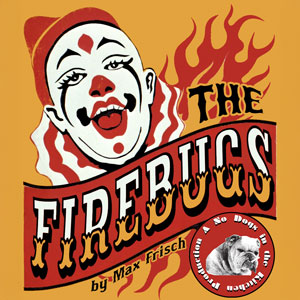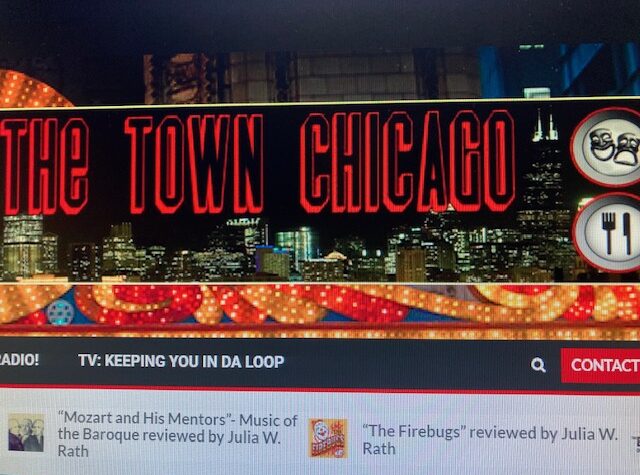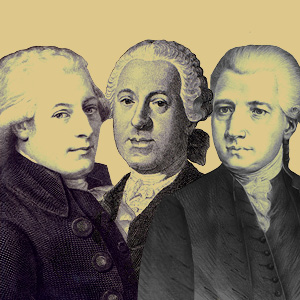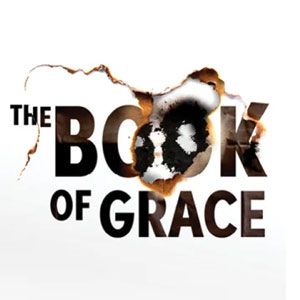
 **** Relevant and timely, “The Firebugs” is best summed up by the advance piece as “a darkly amusing parody about willful blindness to imminent danger [and] the perfect parable to accompany the precarious times we’re experiencing today.” Originally written in German by Swiss playwright and novelist Max Frisch and first performed in 1958, this beautifully co-directed play by Jeremy Osinga and Sara Corkery is a combination psychological drama and burlesque. It shows us how good and honest people are willing to overlook character defects in others and can be easily taken in by those who prey upon them. The story delves into the nature of criminal mischief and the slow but steady encroachment of evil. It is also a statement about how anarchy and nihilism can exist independently of any particular ideology or philosophy. Most importantly, no one would dare say aloud that they intend to destroy people and what they have worked for—just for the hell of it. Or perhaps they would! In fact, one of the most memorable lines in the play goes like this: “The best camouflage is telling the truth.” To put this another way: If what you’re saying is so outrageous and completely outside of the traditional norms for behavior, then no one will believe you even when you’re being sincere.
**** Relevant and timely, “The Firebugs” is best summed up by the advance piece as “a darkly amusing parody about willful blindness to imminent danger [and] the perfect parable to accompany the precarious times we’re experiencing today.” Originally written in German by Swiss playwright and novelist Max Frisch and first performed in 1958, this beautifully co-directed play by Jeremy Osinga and Sara Corkery is a combination psychological drama and burlesque. It shows us how good and honest people are willing to overlook character defects in others and can be easily taken in by those who prey upon them. The story delves into the nature of criminal mischief and the slow but steady encroachment of evil. It is also a statement about how anarchy and nihilism can exist independently of any particular ideology or philosophy. Most importantly, no one would dare say aloud that they intend to destroy people and what they have worked for—just for the hell of it. Or perhaps they would! In fact, one of the most memorable lines in the play goes like this: “The best camouflage is telling the truth.” To put this another way: If what you’re saying is so outrageous and completely outside of the traditional norms for behavior, then no one will believe you even when you’re being sincere.
The story focuses on Gottlieb Biederman (Jared Goudsmit) and his wife Babette (Mary Di Leo), who live in fear of arsonists in a community where fires have become a common occurrence. The Biedermans are comfortably middle-class or bourgeois: They own their own home and can afford a few luxuries, which we see on their dining table; plus, Babette dresses very elegantly. They also employ a domestic servant named Anna (Lilly Caines). Babette, in particular, is scared that one of these arsonists could be hiding among them and might torch their house one evening. While this could be a random occurrence, it’s equally possible that they might be targeted because they have some money.
One day, a wrestler named Sepp Schmitz (Garrett Wiegel) asks if he could stay overnight at the Biederman’s home. He says that it’s raining outside and he has nowhere to sleep. Gottlieb is a good-hearted man and escorts him to the attic, while Babette fears that the man could possibly be an arsonist. But Gottlieb reassures her that Schmitz is okay and makes sure that Babette offers him a good breakfast the next morning. But while Schmitz has his designs on Babette, these are overshadowed by his larger purpose, that is, to bring his associate Willi Maria Eisenring (Jeremy Osinga) into the house. That is when the two of them surreptitiously move large industrial storage containers into the Biedermans’ attic.
All the while, Gottlieb is alternately hospitable and suspicious of the two men. Initially he could not entertain the thought that they might actually be firebugs. Even when both tell him separately that they have been in prison, this is not enough of a hint that something could possibly be wrong. Most importantly, Gottlieb doesn’t want to believe his eyes—or more essentially, his sense of smell—when he goes upstairs and sees for himself the large number of containers labeled “Gasoline.” Once Gottlieb becomes ambiguous about his situation and starts making excuses about it, he basically enables the criminals. He simultaneously ignores them and their actions and even believes that the two could become his friends. Above all, he fails to call the authorities, such as the police officer (Eric Edstrom).
The name Gottlieb literally means “God-love”, or one who loves God, and his last name Biederman means “honest” and “upright.” Then there is Babette, whose name means “my God is my oath.” Their names reflect both personal faith in God and in God’s creation: humanity. By all measure, Gottlieb is a religious humanist, who cannot comprehend that there are some people who get their thrills by inflicting harm on others, often for no reason at all. But the show starts (and largely ends) with the professor/Ph.D. (JP Panek), who believes in secular humanism: more specifically, in the idea of progress and humanity’s growing perfection. His character is shorthand for the fact that he sees science as a means of inventing medical cures and new technologies and developing new ways to study the earth and the universe, as well as promoting the scientific study of the society, the economy, and the government, so as to benefit humanity as a whole. Like Gottlieb, he is equally naïve in his faith about the innate goodness of people. Both therefore refuse to believe that there are people around them who enjoy inflicting pain and suffering on others—and relish the power of fire. While those involved in various causes may use arsonists like Schmitz and Eisenring to start trouble for their own ends or to advance a specific religious or political agenda, they eventually must realize that these corrosive narcissists simply like violence for its own sake. True firebugs, above all, enjoy sabotage and are bent on destruction. Morality and ethics are merely religious constructs that don’t concern them, and the idea of progress and the perfectibility of humankind is a secular illusion.
While the audience is not privy to the scenario that gave rise to the fires and the arsonists, what we do know is that these are people who live in the shadows, if not also in the subconscious mind. In the play, they are depicted by the clowns/chorus: the burlesque performers who are part of the fire department. We never know if they put out fires or start them or some of both. Featuring Aidan Beasley, Jacob Beasley, Madi Bolin, Leo Kamm, and Elizabeth Sacha, their clownlike appearances represent the theatre of the absurd and those who believe in the nonsensicalness of life. As they hide their true feelings behind masks and face paint, we can only suspect their sinister motives as they pretend to do good. Like the Greek chorus, they come together to explain what is happening, as they sing and dance and entertain the audience. Kudos to Elizabeth Sacha for such wonderful choreography! Original musical compositions written for this show are marvelous and add to the chaos, due to the fine work of Julia Cicero. Plus, recorded music in advance of the performance nicely sets the tone, having to do with fires and burning, such as Jerry Lee Lewis’s “Great Balls of Fire” and Johnny Cash’s “The Ring of Fire”, etc. Co-sound designers Grace Patterson and Andrew Speidel have done a great job!
Set design by Marcus Petrella works well for this production. Wooden planks have been placed horizontally along one wall to give the appearance of an attic, and from the beginning, we see the flickering lights of fire behind them, thanks to Eli Green’s lighting design. A step below is the “downstairs” part of the house, which centers around a dining table. Props by assistant prop designer and actor Lilly Caines and outfits by costume design by Emma Millisor are cleverly done, with the colors of red being everywhere, from the boots and belt being worn by Schmitz, to the red dress and heels worn by Babette, to the fire hose that lines the exterior of the stage floor at the beginning of the show. My favorite prop, however, is the Jack-in-the-Box in the corner! Speaking of clowns, Millisor’s makeup and costume design is superior, and each clown has its own personality! While they all wear a Florian cross patch (that is, a symbol used by the majority of fire departments around the world), it was fun to see the chorus hold props that might traditionally be held by firefighters, such as hatchet and shovel—and a squeegee!
The revival of “The Firebugs” reminds us what can happen when adherence to an unrealistic view of humanity’s goodness can potentially lead to a result that no one could have predicted or wanted. Both Gottlieb’s and the professor’s hopeful, if not magical, thinking blinds them to the truth of their circumstances and their gradual inevitability, while the audience can clearly see what is really going on. As my guest put it, “The show reminds me of Elon Musk and his chainsaw.” She described the production as a clarion call to take direct action today to prevent a disaster of historic proportions.
“The Firebugs” is playing at City Lit Theatre, 1020 W. Bryn Mawr Avenue, Chicago, through April 13, 2025.
Tickets range from $22.13-$32.64
There are only six performances in total:
April 4, 5, 11, and 12 at 8:00 p.m.
April 6 and 13 at 3:00 p.m.
Tickets are available online at https://www.simpletix.com/e/the-firebugs-tickets-206800 or at the door.
For more information about this show and to see No Dogs in the Kitchen’s other offerings, visit: https://saintgenesiusproductions.com/nodogs/.
To see what others are saying, visit www.theatreinchicago.com, go to Review Round-Up and click at” The Firebugs”.





More Stories
“The Book of Grace” Al Bresloff with another from Paul LIsnek
“The Last Five Years” MILWAUKEE
“The Trial of Themistocles” reviewed by Julia W. Rath